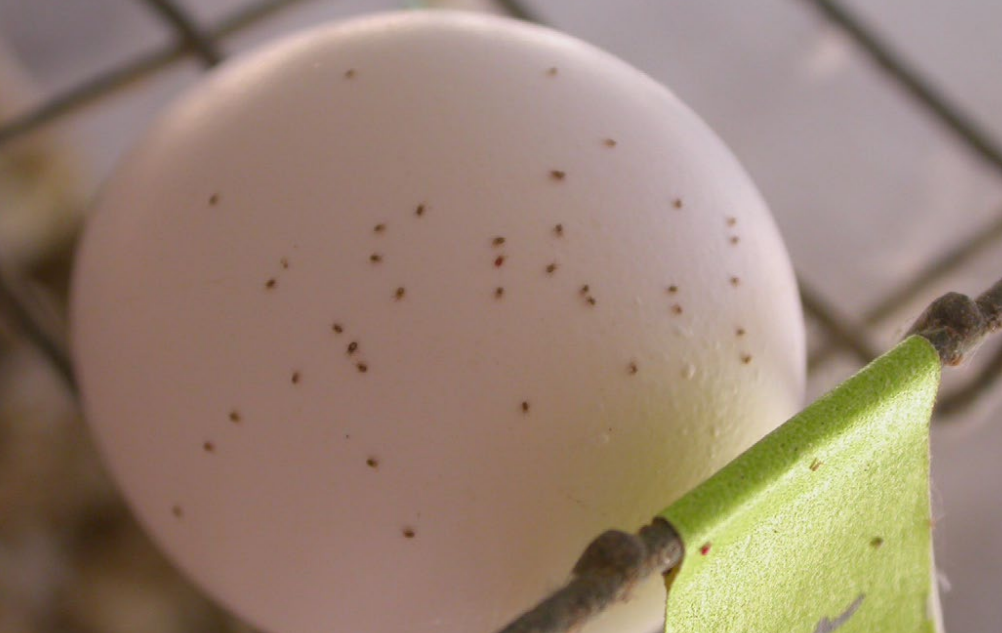



Northern Fowl Mite: an overview, treatment and prevention
Hy-Line's technical team provides an overview to Northern Fowl MiteIntroduction
The northern fowl mite is regarded as the primary and most serious external parasite of poultry in North America. This particular mite is common on wild birds and rodents, which can readily introduce it into poultry production facilities.
The entire life cycle is spent on the host, where it feeds on blood and is a source of irritation to the bird. The mite can lay a large number of eggs at the base of the feathers, usually in the vent area of the bird. Northern fowl mites prefer temperatures around 65 to 68° F and are often more of a problem during cool weather, but they may be found on birds at any time of year.
Northern fowl mites will generally die within 3–4 days without a host, but well-fed northern fowl mites may survive up to 2–3 weeks off the host at room temperature.

Life cycle
The eight-legged adult northern fowl mite is very small and dark red to black in color. There are four stages in the mite life cycle: egg, larva, nymph, and adult. The complete life cycle from egg to egg-laying female can be as little as 5 days. This can result in rapid increases in mite populations, especially on layers and breeders kept for extended periods. Female adult mites lay eggs directly on their host. Adult female mites complete the egg-laying process in two days after taking a blood meal from their host.
The eggs hatch in 1–2 days, depending on the temperature and humidity. This short life cycle means that mite populations can rise rapidly. Mites tend to congregate near the vent area, but the back is also a popular site as the mite population increases.
Transmission
Mites are easily transmitted from bird to bird by direct contact or by crawling from one bird to another. A mite-free house can become infested by several different methods, including: people, a contaminated pullet hauling trailer, the introduction of an infested pullet flock, wild birds, rodents or contaminated egg flats and racks that are hauled from farm to farm by the egg truck. A severe northern fowl mite infestation can develop and spread through a flock in 3–6 weeks. Light infestations of mites often go unnoticed and are difficult to identify. In a flock of breeder birds, the roosters often have higher populations of northern fowl mites than the hens. Mites readily spread from the roosters to the hens; therefore, roosters should be examined at a higher ratio to the hens.
Northern fowl mites can be found on the feathers surrounding the vent area (top), as well as on eggs and egg belts (bottom). Photos courtesy Dr. Bradley Mullens, University of California, Riverside.
Symptoms
Heavier infestations produce a dark grey discoloration and matting of feathers around the vent. The discoloration is the result of large populations of mites, mite eggs, their feces and shed skins. Other symptoms include:
- Reduced feed intake and rapid loss of body weight
- Anemia (exhibit pale combs) andimmunosuppression (more susceptible toother diseases)
- Decreased egg production +/- elevated mortality
Treatment
- Addition of feed grade sulfur (e.g. Poultry Shield FG) starting at 2 lbs/ton for 1 week, then 3 lbs/ton for 1 week
- Dust boxes using sulfur dust (e.g. Yellow Jacket) – using 20–30 shallow plastic boxes per barn (must be able to disinfect the boxes)
- Spraying both birds (focusing on vent areas) and nests with Ravap insecticide every 5 days (monitor birds and repeat as necessary); spray pressure should be 125 PSI to ensure penetration of spray past feathers.
- Spray at 5-day intervals (e.g. day 0, day 5, day 10, etc.)
Prevention
Prevention is by far the best and most effective method of northern fowl mite control.
- Take steps to exclude mite vectors such as wild birds and rodents from the poultry house, and prevent the movement of mites from one farm to another on egg flats, racks, other equipment, or people
- Promptly clean up spilled feed around feed bins or elsewhere before it attracts wild birds and rodents
- Maintain bait stations along exterior and binterior poultry house walls year-round, when birds are present and in between flocks
- Keep wild birds and rodents out of production houses means sealing up the holes and any possible entry points
- Monitoring birds on a weekly or bi-monthly basis is critical to detecting a mite problem early
- Isolate infected farms, and readjust traffic flows from infested to clean farms and take precautions with all protective clothing worn
- At the hatchery, pay close attention to egg deliveries from infested farms; this includes strictly managing personnel, vehicles, racks, egg flats, and other equipment that have contact with infested farms









